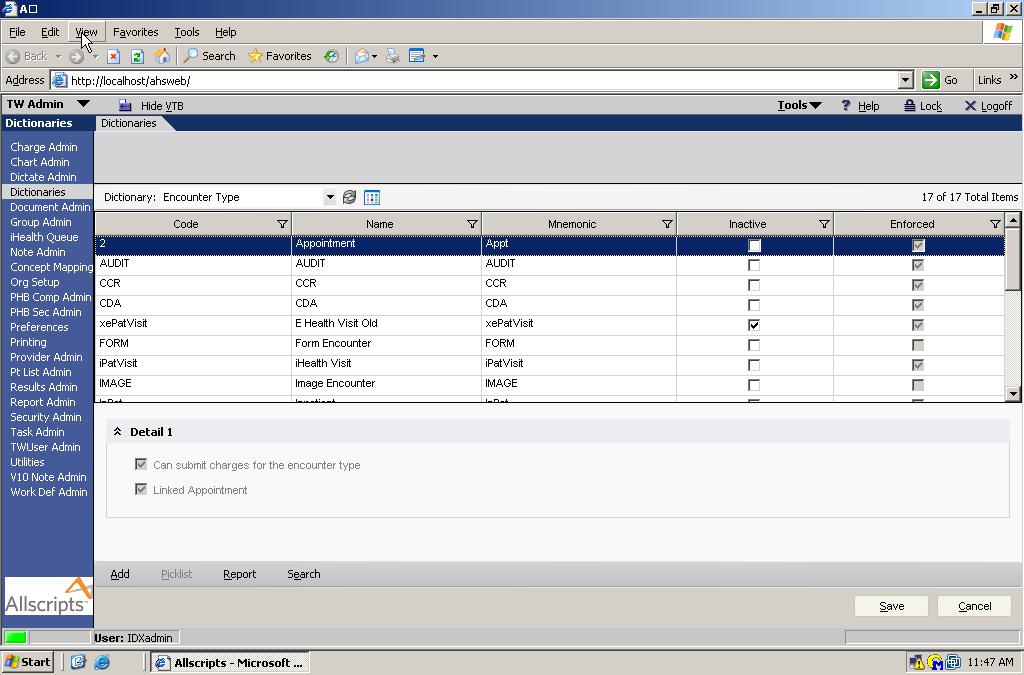Difference between revisions of "Encounter Type"
Max.Stroud (talk | contribs) |
|||
| Line 11: | Line 11: | ||
Appointment—default used for appointments that come across the | Appointment—default used for appointments that come across the | ||
scheduling interface; a specific encounter type can be entered in | scheduling interface; a specific encounter type can be entered in | ||
| − | the Scheduling application and sent across the scheduling interface | + | the Scheduling application and sent across the scheduling interface |
| − | Message—used for patient Notes copied from Mail | + | Message—used for patient Notes copied from Mail |
Other—used for results and transcriptions that come across the | Other—used for results and transcriptions that come across the | ||
| − | interface and create an encounter | + | interface and create an encounter |
Telephone Call—used for patient Notes copied from Call Processing | Telephone Call—used for patient Notes copied from Call Processing | ||
| − | |||
| − | |||
| − | |||
| − | |||
| + | This dictionary is called from: | ||
| + | Note, | ||
| + | Encounter Form Selector, | ||
Encounter Summary | Encounter Summary | ||
Revision as of 20:26, 31 December 2008
Back to Touchworks v11 Dictionaries
Description
The Encounter Type dictionary is used to define the types of encounters. All clinical data in TouchWorks must be tied to an encounter. Encounters can be created by appointments sent via the scheduling interface, notes created via call processing, and results and transcriptions that come across the interface that are not already tied to an encounter. The following encounter types are used within TouchWorks. Appointment—default used for appointments that come across the scheduling interface; a specific encounter type can be entered in the Scheduling application and sent across the scheduling interface Message—used for patient Notes copied from Mail Other—used for results and transcriptions that come across the interface and create an encounter Telephone Call—used for patient Notes copied from Call Processing
This dictionary is called from:
Note,
Encounter Form Selector,
Encounter Summary
Definition
- Code - The Code is a unique identifier that must be supplied. This is not displayed in the product and is used for identification purposes only.
- Name - This is the name that will appear for the end users in the EHR application. This should be unique to prevent confusion.
- Mnemonic - This is not required, but it used as a secondary identifier. This does not appear in the product and unless you have another use for it, the recommendation would be to make this the same as the code.
- Inactive - The inactive flag allows you to inactivate or hide an entry.
- Enforced - The enforced flag designates whether a dictionary item is required and cannot be changed. In most cases, this comes predefined by Allscripts and should not be selected for new entries. If an entry is enforced, it cannot be modified or inactivated.
- Can Submit Charges for the Encounter Type -enables this encounter type to be selected when TouchWorks prompts for which encounter to
enter the charges. This can be used to enable any non-appointment encounter type to be available to any user within Charge, where when launching the encounter selector from within charge, only encounters with this flag are selectable.
- Linked Appointment - indicates whether this encounter type is linked to an appointment from the practice management system. If so, Submit Enc Form tasks will be created once the patient has been arrived.
